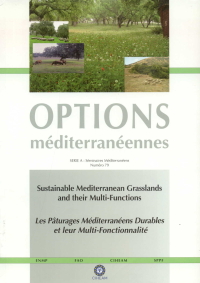| Article précédent | p. 237-240 | Article suivant |
Phenologic observations and agronomic features of three local Poaceae fodder grasses in North East Algeria
A behavioural test was applied to highlight the phenologic stages and the notation of some agronomic features of three local fodder grasses, Lolium multiflorum Lamk, Festuca arundinacea Schreb and Phalaris arundinacea L. The results obtained show that generally, the three species present higher germinating ability in laboratory conditions, and good germination (>70%) in the soil. With regard to the phenologic stages, it was noted that the ryegrass and the tall fescue had similar chronological evolution. The red canary grass cycle was different. Otherwise, the notation of agronomic characters showed that in the shooting stage, ryegrass was vulnerable to lodging; tall fescue was less vigorous during winter, especially in the first year of sowing. The following years, the tall fescue reacted better to cold weather conditions, dryness and floods. The red canary grass was slightly sensitive to rust and oidium diseases. As a whole, these ecotypes seem to have quite good general rusticity.
Ce travail consiste en un essai de comportement pour mettre en évidence la phénologie et la notation de certaines caractéristiques agronomiques de trois graminées fourragères locales : Lolium multiflorum Lamk, Festuca arundinacea L. et Phalaris arundinacea L.). Les résultats obtenus montrent que d'une manière générale, les trois espèces présentent une faculté germinative assez bonne (>70%). En ce qui concerne les stades phénologiques, on constate que le ray-grass et la fétuque ont une évolution chronologique similaire contrairement à l'alpiste. Les caractères agronomiques montrent que le ray-grass est vulnérable à la verse surtout au stade montaison; la fétuque est moins vigoureuse pendant l'hiver surtout, la première année de semis. Les années suivantes, elle réagit mieux au froid, à la sécheresse et à l'inondation. Par contre l'alpiste est légèrement sensible aux maladies: rouille et oïdium. D'une manière générale, ces écotypes semblent présenter dans l'ensemble une rusticité assez bonne.
- [ Afficher ]
- [ Télécharger ]
- [ Exporter la citation ]
Vous pouvez télécharger la citation au format :
- [ Imprimer ]
-
Mots-clés
CARACTERE AGRONOMIQUE, FESTUCA ARUNDINACEA, GRAMINEE FOURRAGERE, LOLIUM MULTIFLORUM, PHALARIS ARUNDINACEA, PHENOLOGIE, RESISTANCE AUX FACTEURS NUISIBLESCiter cet article
Slimani S., Boudelaa M., Boutebba A., Tahar A. Phenologic observations and agronomic features of three local Poaceae fodder grasses in North East Algeria. In : Porqueddu C. (ed.), Tavares de Sousa M.M. (ed.). Sustainable Mediterranean grasslands and their multi-functions . Zaragoza : CIHEAM / FAO / ENMP / SPPF, 2008. p. 237-240. (Options Méditerranéennes : Série A. Séminaires Méditerranéens; n. 79). 12. Meeting of the Sub-Network on Mediterranean Forage Resources of the FAO-CIHEAM Inter-regional Cooperative Research and Development Network on Pastures and Fodder Crop, 2008/04/09-12, Elvas (Portugal). http://om.ciheam.org/om/pdf/a79/00800654.pdf



